
Credit: Credit: NAOJ/HSC-SSP
Astronomers have applied artificial intelligence (AI) to ultra-wide field-of-view images of the distant Universe captured by the Subaru Telescope, and have achieved a very high accuracy for finding and classifying spiral galaxies in those images. This technique, in combination with citizen science, is expected to yield further discoveries in the future.
A research group, consisting of astronomers mainly from the National Astronomical Observatory of Japan (NAOJ), applied a deep-learning technique, a type of AI, to classify galaxies in a large dataset of images obtained with the Subaru Telescope. Thanks to its high sensitivity, as many as 560,000 galaxies have been detected in the images. It would be extremely difficult to visually process this large number of galaxies one by one with human eyes for morphological classification. The AI enabled the team to perform the processing without human intervention.
Automated processing techniques for extraction and judgment of features with deep-learning algorithms have been rapidly developed since 2012. Now they usually surpass humans in terms of accuracy and are used for autonomous vehicles, security cameras, and many other applications. Dr. Ken-ichi Tadaki, a Project Assistant Professor at NAOJ, came up with the idea that if AI can classify images of cats and dogs, it should be able to distinguish “galaxies with spiral patterns” from “galaxies without spiral patterns.” Indeed, using training data prepared by humans, the AI successfully classified the galaxy morphologies with an accuracy of 97.5%. Then applying the trained AI to the full data set, it identified spirals in about 80,000 galaxies.
Now that this technique has been proven effective, it can be extended to classify galaxies into more detailed classes, by training the AI on the basis of a substantial number of galaxies classified by humans. NAOJ is now running a citizen-science project “GALAXY CRUISE,” where citizens examine galaxy images taken with the Subaru Telescope to search for features suggesting that the galaxy is colliding or merging with another galaxy. The advisor of “GALAXY CRUISE,” Associate Professor Masayuki Tanaka has high hopes for the study of galaxies using artificial intelligence and says, “The Subaru Strategic Program is serious Big Data containing an almost countless number of galaxies. Scientifically, it is very interesting to tackle such big data with a collaboration of citizen astronomers and machines. By employing deep-learning on top of the classifications made by citizen scientists in GALAXY CRUISE, chances are, we can find a great number of colliding and merging galaxies.”
###
Media Contact
Hideaki Fujiwara
[email protected]
Original Source
https:/
Related Journal Article
http://dx.





